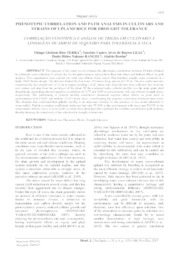Phenotypic correlation and path analysis in cultivars and strains of upland rice for drought tolerance.
Phenotypic correlation and path analysis in cultivars and strains of upland rice for drought tolerance.
Author(s): TERRA, T. G. R.; LEAL, T. C. A. de B.; RANGEL, P. H. N.; BORÉM, A.
Summary: The purpose of this study was to estimate the phenotypic correlations between 14 traits obtainedin a thematic core collection of upland rice for drought tolerance and partition them into direct and indirect effects by path analysis. Two experiments were carried out (with and without water stress). One hundred samples were evaluated in a triple 10x10 lattice design. The plot was formed by four rows, 3.0 metres long, spaced at 0.35 m. The plot useful area was constituted by two central rows of 2.0 m in length, totalling 1.4 m2, where data from 14 traits were collected, five from the root system and nine from the aerial part of the plant. Of the evaluated traits, spikelet sterility was the main grain yield determinant, presenting relevant negative correlations of -0.77 and -0.59 in environments with and without drought stress, respectively. The partitioning of spikelet sterility correlations presented negative direct effects on grain yield in environments with (-0.60) and without (-0.62) water stress, corroborating the negative correlations between these traits. The obtained data confirmed that spikelet sterility is an important variable for the selection of rice strain submitted to water deficit. Partial correlation coefficients indicated that only 70.33% in the environment with stress and 50.30% in the environment without stress of grain yield variation were phenotypically explained by variables considered in path analysis, thereby showing the complexity of the selection for drought-tolerant rice.
Publication year: 2017
Types of publication: Journal article
Unit: Embrapa Rice & Beans
Observation
Some of Embrapa's publications are published as ePub files. To read them, use or download one of the following free software options to your computer or mobile device. Android: Google Play Books; IOS: iBooks; Windows and Linux: Calibre.
Access other publications
Access the Agricultural Research Database (BDPA) to consult Embrapa's full library collection and records.
Visit Embrapa Bookstore to purchase books and other publications sold by Embrapa.

